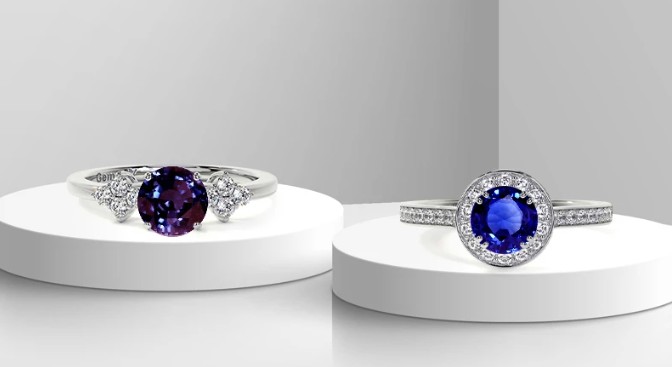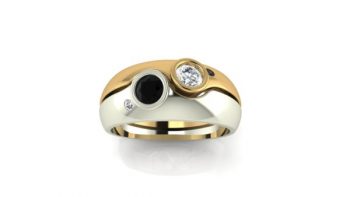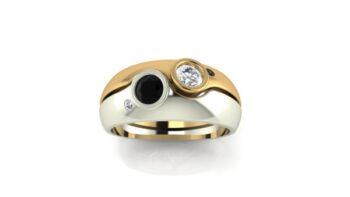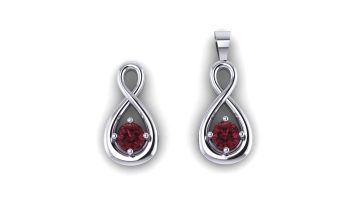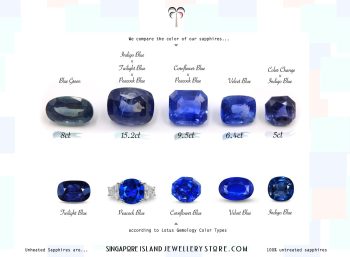 If you are talking about blue gemstones, it is impossible to leave out the rich and stunning blues of Blue Sapphire vs Blue Spinel. These two gemstones have captured the minds and hearts of people for thousands of years. Although mainly relegated to the royals and uber rich in history, these stones are now worn by anyone who wants one. This is mainly because lab grown sapphire and spinel make the choice so affordable. However, that isn’t to say that you can’t find natural specimens that won’t break the bank.
If you are talking about blue gemstones, it is impossible to leave out the rich and stunning blues of Blue Sapphire vs Blue Spinel. These two gemstones have captured the minds and hearts of people for thousands of years. Although mainly relegated to the royals and uber rich in history, these stones are now worn by anyone who wants one. This is mainly because lab grown sapphire and spinel make the choice so affordable. However, that isn’t to say that you can’t find natural specimens that won’t break the bank.
In this post we will compare Blue Sapphire vs Blue Spinel. We will discuss the colors they come in, physical properties, pros & cons, as well as their histories and notable stones in history.
What Is Blue Spinel?
Blue spinel is a gemstone that is known for its stunning blue color. It is a type of spinel, which is a mineral that belongs to the same family as rubies and sapphires. Blue spinel is highly valued for its vibrant hue and is often used in jewelry, particularly in rings and necklaces.
One of the reasons why blue spinel is so sought after is its rarity. While spinel can be found in a variety of colors, including red, pink, and purple, blue spinel is relatively uncommon. This makes it a unique and special gemstone to own.
In addition to its beauty and rarity, blue spinel also has a number of metaphysical properties. It is believed to promote calmness and tranquility, making it a popular choice for those seeking inner peace. Blue spinel is also said to enhance communication and self-expression, making it a great stone for those who want to improve their communication skills. Overall, blue spinel is a gemstone that combines beauty, rarity, and metaphysical properties, making it a truly special stone.
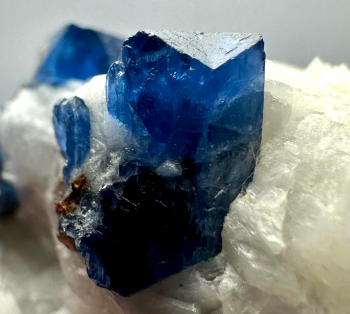
History Of Blue Spinel
Blue spinel is a gemstone that has a rich history dating back centuries. It is a variety of spinel, which is a mineral that is often mistaken for other gemstones such as sapphire or ruby. Blue spinel gets its stunning blue color from trace elements of cobalt or iron within its crystal structure.
The history of blue spinel can be traced back to ancient times, where it was highly valued and used in jewelry and decorative objects. It was particularly popular during the Renaissance period, where it was often used in royal and noble jewelry. Blue spinel was also highly sought after in the Victorian era, where it was believed to bring good luck and protect against evil spirits.
Today, blue spinel continues to be a popular gemstone choice for jewelry. Its vibrant blue color, combined with its durability and affordability, make it a desirable option for those looking for a unique and eye-catching piece. Whether set in a ring, necklace, or earrings, blue spinel is sure to make a statement and add a touch of elegance to any outfit.
Notable Spinel Gemstones From History
Blue spinel gemstones have a rich history, with several notable specimens that have captivated gem enthusiasts throughout the years. One such gem is the Hope Spinel, a stunning pink spinel that was once mistaken for a sapphire. It weighs an impressive 50.13 carats and is currently housed in the British Museum.
Another famous blue spinel is the Black Prince’s Ruby, which is actually a spinel and not a ruby as its name suggests. This gem has a deep blue color and is set in the Imperial State Crown of England. Lastly, the Samarian Spinel is a remarkable spinel that was discovered in the ancient city of Samaria. It is known for its vibrant blue hue and is considered one of the most important spinels in the world. These blue spinel gemstones are not only visually stunning, but also hold significant historical and cultural value.

Blue Spinel Chemical Composition & Physical Properties
Blue spinel is a gemstone that belongs to the spinel mineral group. It is often mistaken for blue sapphire due to its similar color. Its chemical composition is primarily made up of aluminum and oxygen, with traces of other elements such as magnesium and iron. The presence of these elements gives blue spinel its vibrant blue color.
In terms of physical properties, blue spinel has a hardness of 8 on the Mohs scale, making it a durable gemstone suitable for everyday wear. It has a refractive index of 1.72-1.82, which gives it a brilliant sparkle when cut and polished. Blue spinel also has a specific gravity of 3.6-4.0, indicating its density.
Pros & Cons Of Blue Spinel
Blue spinel is a gemstone that has gained popularity in recent years. It is known for its vibrant blue color and its affordability compared to other blue gemstones like sapphires. There are several pros and cons to consider when it comes to blue spinel.
One of the main advantages of blue spinel is its stunning color. The deep blue hue of blue spinel is often compared to that of sapphires, making it a desirable choice for those who want a blue gemstone without the high price tag. Additionally, blue spinel is known for its brilliance and clarity, which adds to its overall beauty.
Another benefit of blue spinel is its durability. With a hardness rating of 8 on the Mohs scale, blue spinel is a durable gemstone that can withstand everyday wear and tear. This makes it a practical choice for jewelry, especially for those who lead an active lifestyle.
However, it is important to consider some drawbacks of blue spinel as well. One of the main cons is its availability. While blue spinel is becoming more popular, it is still not as widely available as other gemstones. This can make it more difficult to find a specific blue spinel stone or piece of jewelry.
Another disadvantage of blue spinel is its color variation. While blue spinel is known for its vibrant blue color, it can also occur in shades of gray, green, and violet. This can make it challenging to find a blue spinel stone with the exact shade of blue that you desire.
What Is Blue Sapphire
Blue Sapphire is a precious gemstone that is known for its stunning blue color. It is a variety of the mineral corundum, which is also the same mineral that forms rubies. Blue Sapphire is highly valued for its beauty and rarity, making it a popular choice for jewelry.
One of the most important factors that determine the value of a Blue Sapphire is its color. The most desirable color is a deep, velvety blue, often referred to as “cornflower blue.” However, Blue Sapphires can also come in a range of other shades, including lighter blues, purples, and even greenish blues. The presence of certain trace elements, such as iron and titanium, is what gives Blue Sapphire its distinctive blue color.
In addition to its beauty, Blue Sapphire is also believed to possess various metaphysical properties. It is said to symbolize wisdom, loyalty, and nobility. Many cultures throughout history have considered Blue Sapphire to be a stone of protection and good fortune. It is also believed to promote mental clarity and enhance intuition.
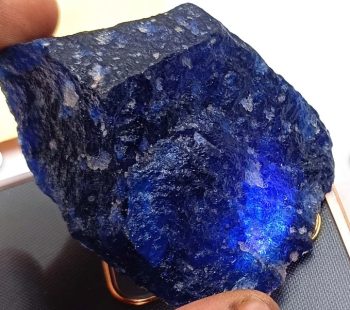
History Of Blue Sapphire
Blue sapphire is a gemstone that has a rich and fascinating history. It has been prized for its beauty and rarity for centuries. The gemstone is a variety of the mineral corundum, which is also the mineral that forms rubies. Blue sapphire gets its stunning blue color from trace amounts of iron and titanium in its crystal structure.
The history of blue sapphire dates back to ancient times. It was highly valued by civilizations such as the ancient Egyptians, Greeks, and Romans. In these cultures, blue sapphire was associated with royalty and believed to bring protection, wisdom, and good fortune. It was often worn by kings and queens as a symbol of their power and status.
Throughout history, blue sapphire has been used in jewelry and as a talisman. It has been believed to have various healing properties, such as promoting mental clarity and enhancing intuition. Today, blue sapphire continues to be a popular gemstone in jewelry, admired for its vibrant blue color and timeless elegance.
Notable Blue Sapphire Gemstones From History
Blue sapphire gemstones have a rich history and have captivated people for centuries. One notable blue sapphire is the Star of India, a 563-carat gem that is one of the largest of its kind. It is known for its stunning blue color and its unique star-shaped inclusion, which gives it its name. Another famous blue sapphire is the Logan Sapphire, a 423-carat gem that is part of the Smithsonian’s National Gem Collection. It is renowned for its deep blue hue and its flawless clarity. Lastly, the Blue Belle of Asia is a 400-carat blue sapphire that is considered one of the finest gemstones in the world. Its vibrant blue color and impressive size make it a true treasure. These notable blue sapphires have left a lasting impression on gemstone enthusiasts and continue to be admired for their beauty and rarity.
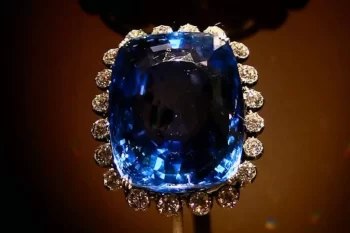
Blue Sapphire Chemical Composition & Physical Properties
Blue sapphire is a precious gemstone known for its stunning blue color. Its chemical composition consists of aluminum oxide, with trace amounts of iron and titanium giving it its distinct hue. The physical properties of blue sapphire include a hardness of 9 on the Mohs scale, making it one of the hardest gemstones. It also has a specific gravity of 3.99 to 4.01, and a refractive index of 1.76 to 1.78. These properties contribute to the durability and brilliance of blue sapphire, making it a popular choice for jewelry.
Pros & Cons Of Blue Sapphire
Blue sapphire is a gemstone that has both pros and cons. On the positive side, blue sapphire is known for its stunning beauty and rich color. It is a highly sought-after gemstone for jewelry, especially engagement rings. Blue sapphire is also believed to have various metaphysical properties, such as promoting wisdom, intuition, and mental clarity. However, there are also some potential drawbacks to consider. Blue sapphire can be quite expensive, especially if it is of high quality. Additionally, some people may find the deep blue color of blue sapphire to be too intense for their taste. Overall, blue sapphire is a beautiful gemstone with both advantages and disadvantages.
Blue Sapphire vs Blue Spinel
Price – When comparing the cost of Blue Sapphire and Blue Spinel, there are a few key factors to consider. Firstly, Blue Sapphire is generally more expensive than Blue Spinel due to its rarity and popularity in the jewelry industry. The price of Blue Sapphire can vary greatly depending on factors such as size, quality, and origin. On the other hand, Blue Spinel is often considered a more affordable alternative to Blue Sapphire, offering a similar vibrant blue color at a lower price point. However, it’s important to note that the cost of Blue Spinel can also vary depending on its quality and size.
Color – Blue Sapphire and Blue Spinel are both stunning gemstones that are prized for their beautiful blue color. While they may appear similar at first glance, there are some key differences between the two.
Blue Sapphire is a precious gemstone that is known for its rich, deep blue color. The color of a blue sapphire can vary from a pale blue to a deep navy blue, with the most desirable stones having a vibrant, intense blue hue. Blue sapphires are often associated with royalty and are a popular choice for engagement rings and other fine jewelry.
On the other hand, Blue Spinel is a semi-precious gemstone that is also known for its blue color. However, the color of a blue spinel tends to be lighter and less intense than that of a blue sapphire. Blue spinels can range in color from a pale blue to a medium blue, and they often have a slightly grayish or violet undertone. While blue spinels are not as valuable as blue sapphires, they are still highly regarded and can make a beautiful addition to any jewelry collection.


Durability –
Blue sapphire and blue spinel are both popular gemstones known for their stunning blue color. When it comes to durability, however, there are some differences to consider.
Blue sapphire is a very durable gemstone, ranking 9 on the Mohs scale of hardness. This means that it is highly resistant to scratches and can withstand everyday wear and tear. It is also known for its excellent toughness, which means it is less likely to chip or break.
Conversely, blue spinel is not as durable as blue sapphire. It ranks 8 on the Mohs scale, which makes it slightly less resistant to scratches. While it is still a relatively durable gemstone, it may require more care and attention to prevent damage.
Blue Sapphire vs Blue Spinel – Which Is Better?
The Short answer is neither. There is no clear winner when it comes to Blue Sapphire vs Blue Spinel. If choosing between blue sapphire and blue spinel, it’s important to consider their unique qualities. Blue sapphire is a precious gemstone known for its stunning deep blue color and durability. It is highly valued for its rarity and is often associated with royalty. On the other hand, blue spinel is a lesser-known gemstone that offers a similar blue hue but at a more affordable price point. While blue sapphire may be the more traditional choice, blue spinel can be a great alternative for those looking for a beautiful blue gemstone without breaking the bank. Ultimately, the decision between blue sapphire and blue spinel comes down to personal preference and budget.
We Create Custom Jewelry
We don’t care what you choose in the Blue Sapphire vs Blue Spinel battle. It makes no difference to us. We still create stunning custom jewelry creations that work well with either. You can also see our custom pendants and intriguing rings, then contact us with your idea.
